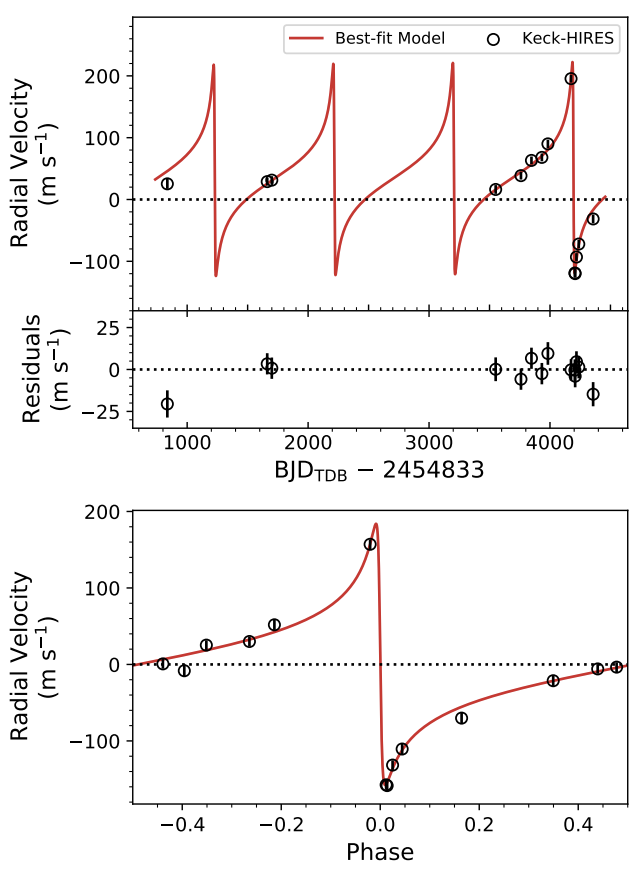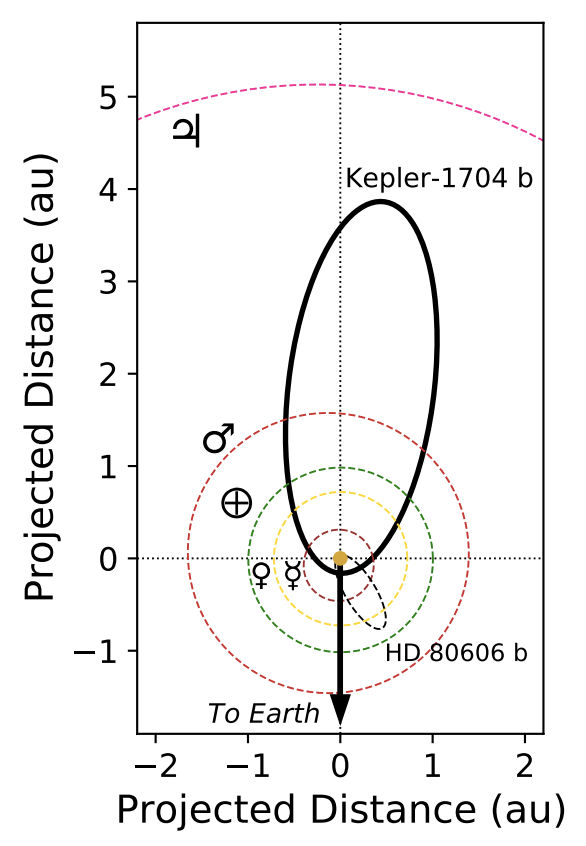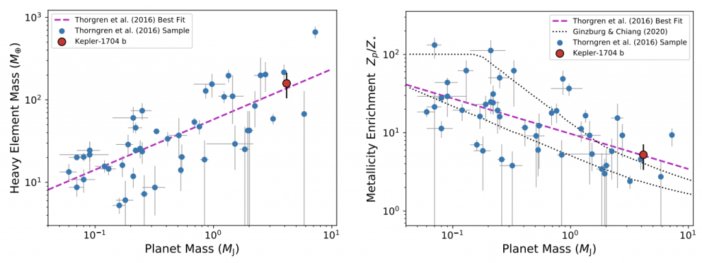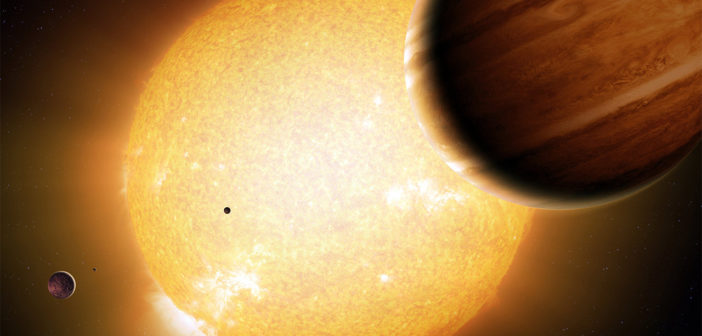Editor’s note: Astrobites is a graduate-student-run organization that digests astrophysical literature for undergraduate students. As part of the partnership between the AAS and astrobites, we occasionally repost astrobites content here at AAS Nova. We hope you enjoy this post from astrobites; the original can be viewed at astrobites.org.
Title: Giant Outer Transiting Exoplanet Mass (GOT ‘EM) Survey. II. Discovery of a Failed Hot Jupiter on a 2.7 Year, Highly Eccentric Orbit
Authors: P. A. Dalba et al.
First Author’s Institution: University of California Santa Cruz
Status: Accepted to AJ
Astronomers have discovered a giant, eccentric exoplanet that orbits its star once every three Earth years. The best part is: we can measure both its radius and its mass!
Guided by Giants
Over the past few decades, astronomers have determined that giant planets are imperative to the formation and evolution of planetary systems. In particular, the migration of giant planets is a driving factor in organizing the architecture of exoplanetary systems (check out this astrobite to learn more about planetary migration).
Astronomers have established two mechanisms for the migration of giant planets: 1) disk-driven migration, and 2) high-eccentricity migration (HEM). While disk-driven migration is caused by torques from the protoplanetary disk, HEM arises when a giant planet exchanges orbital energy and angular momentum with one or more other objects in its system. Studying giant planets and their orbits helps us understand which mechanism led to the present-day planet architecture in a given system.

Figure 1: RV measurements from the Keck-HIRES instrument in black with the best-fit model shown in red. The top panel shows the time-series data, and the bottom panel shows the phase-folded data. [Dalba et al. 2021]
HEM theories are best tested in systems with hot Jupiters. In particular, HEM theorists are looking for hot Jupiters that seem to have formed at greater distances from their host stars and migrated inwards. They are also looking for proto- and failed hot Jupiters: objects that have not yet become hot Jupiters, or that will not become hot Jupiters even though they followed a similar evolutionary pathway.
Socrates et al. (2012) theorized that if HEM is the preferred mechanism for giant-planet migration, then the Kepler mission would detect a population of giant planets with highly elliptical orbits (also known as highly eccentric orbits, with e > 0.9).
Although radial velocity (RV) surveys have detected a handful of failed hot Jupiters, there is only one non-controversial exoplanet with both a highly eccentric orbit and a measured radius: HD 80606 b. However, eccentric, long-period giant planets with measured radii like this are exceedingly valuable, as they offer a window into their formation and migration. The authors of this paper therefore present the second discovery from the Giant Outer Transiting Exoplanet Mass (GOT ‘EM) survey: a new failed hot Jupiter from the Kepler sample: Kepler-1704 b.

Figure 2: Face-on view of the orbit of Kepler-1704 b (solid black line) relative to those of Jupiter (dashed pink line), the solar system terrestrial planets (dashed red, green, yellow, and purple lines), and HD 80606 b (dashed black line). All orbits are drawn to scale, although the size of Kepler-1704 is not. [Dalba et al. 2021]
Got ’Em?
Although the discovery of Kepler-1704 b was unique and exciting, the authors first had to make sure that the decrease in brightness detected by Kepler was actually caused by a giant-planet transit. This event could have instead been created by substellar or stellar objects, or various systematic signals.
In order to vet Kepler-1704 b, the GOT ‘EM survey collected RVs spanning a decade from Keck Observatory near the summit of Mauna Kea in Hawaii. These observations did confirm that the two six-hour transits observed by the Kepler spacecraft were created by Kepler-1704 b (Figure 1). The 10-year baseline of RV measurements also confirmed the 988.88-day orbital period (nearly three years), placing Kepler-1704 b among the top five longest-period, non-controversial transiting exoplanets with precisely measured periods known to date.
A Wild One
Additionally, the authors determined that Kepler-1704 b has an eccentricity of 0.92, which brings it within 0.16 au of its host star and then slingshots it out to 3.9 au (Figure 2). During this orbit, the temperature of Kepler-1704 b fluctuates by over 700 Kelvin!
Using mass and radius measurements, the authors were also able to infer that Kepler-1704 b likely has 150 Earth masses of heavy metals! This metallicity enrichment agrees with several accretion theories, and it contributes additional data to the giant-planet mass–metallicity correlation (Figure 3).

Figure 3: Left: Heavy element mass of giant exoplanets from Thorngren et al. (2016; blue dots and purple dashed line) and Kepler-1704 b (red dot). Right: Metallicity enrichment of giant exoplanets from Thorngren et al. (2016; blue dots and purple dashed line) and Kepler 1704-b (red dot). The dotted black lines show the scatter that can be accounted for by concurrent gas accretion and mergers (Ginzburg & Chiang 2020). [Dalba et al. 2021]
Untangling with Webb
Excitingly, astronomers may soon be able to characterize the atmosphere of the strange Kepler 1704-b. When the James Webb Space Telescope launches later this year, it will have a good shot at measuring a phase curve for Kepler-1704 b as it heats up while approaching its host star. This curve will reveal the planet’s rotation, and whether the atmosphere is “well mixed,” or has a “hot dayside” (Figure 4).

Figure 4: Simulated 4.5-μm phase curve of Kepler-1704 b following Kane & Gelino (2011) compared to “hot dayside” (solid line) and “well mixed” (dashed line) atmospheric models. [Dalba et al. 2021]
As Kepler-1704 b is a long-period failed hot Jupiter with both mass and radius measurements, it offers a unique opportunity to study how giant-planet migration affects the formation and evolution of planetary architectures. Certainly this survey of exciting planets will lead to even more chances to shout, “Got ‘em!”
Original astrobite edited by Alex Gough.
About the author, Catherine Clark:
Catherine Clark is a fourth-year PhD candidate at Northern Arizona University and Lowell Observatory studying astronomy and planetary science. Her research focuses on the smallest, coolest, faintest stars — the M dwarfs — and she uses high-resolution imaging techniques to investigate M-dwarf multi-star systems. She is also working on a graduate certificate in science communication. Previously she attended the University of Michigan, where she studied astronomy & astrophysics, as well as Spanish. Outside of research, she enjoys spending time outdoors hiking and photographing, and spending time indoors playing games and playing with her cats.

